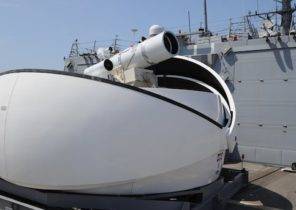
Last week, shipbuilding company Huntington Ingalls and aerospace giant Boeing has announced that they unite their efforts to create an underwater drone Echo Voyager. The goal is to improve the delivery of underwater unmanned systems, naval forces of the United States.
Work on peteducation Echo Voyager is conducted in 2014, in cooperation with DARPA, and recently it became known that Boeing began testing this drone is not already in the test pool, and in the open ocean. Echo Voyager — this is the large develop underwater drone, which belongs to the class XLUUV (extra large unmanned undersea vehicle). While there are short-term immersing on small depth, but the next step will be to send a drone to great depths for a long time. According to the creators, he will be able to spend months in Autonomous navigation, to return independently to base, float to the surface and transmit information. The drone consists of modules, allowing you to equip it for different tasks a certain filling.
Underwater drones are considered as one of the priority directions of development of the naval forces. Potential opponents of the United States, i.e. China and Russia, improving their armed forces and American dominance on the surface of the water is not so obvious and assured.
Another problem is a more sophisticated tracking system for large submarines. The Americans assume that China is building the so-called “underwater great wall” — a system of sensors in real-time tracking of underwater and surface targets.
The third factor is the price of the content of large submarines with numerous crew on Board. Autonomous drones, cheap and without people, look attractive replacement in the near future.
So the Pentagon had the idea to go under water and take advantage of the technological advantage there, creating smaller and less noisy than submarines drones. Ideally, is the creation of “parent” underwater drones that would be carried under water, whole swarms of smaller UAVs of different purposes.
In the past year, rear Admiral Mathias winter (Mathias Winter) said: “the Department of naval research United States (Office of Naval Research, ONR), which deals with the development of advanced technologies in the field of unmanned underwater vehicles, is planning a “backbone network Eisenhower” on the seabed in all the World’s oceans… We want the drones out to sea on a mission once and then acted in the depths of the seas for decades.”
It is about creating underwater bases or technical stations where underwater drones could independently charge or to undergo maintenance, transfer and store the collected information.
According to The Washington Post, the Pentagon planned to allocate about three billion dollars for the development of underwater drones for the next few years.
In addition to Boeing underwater drones works and General Dynamics, which last year acquired robotics company, Bluefin Robotics. Drone Bluefin-21 from the developer can start your underwater micro-drones are Sand Sharks, and even through the pipe to “shoot” a small flying drone to capture air and transfer information.
Lockheed Martin was also able to start flying the drone from his underwater drone, although the underwater drone had to rise to the surface. The plans are almost all dealing with the topic of companies — the creation of a swarm of surface, underwater, flying drones, which can work in conjunction with each other.
By 2020, the Pentagon and the appearance of the first submarine group of drones. At DARPA are thinking about creating the under water storage sleeper drones, which can be at the bottom over the years and to be activated in the event of hostilities.
There is another project — the creation of an underwater counterpart of GPS to underwater drones could navigate the depths of the oceans and not the surface. On the acoustic system of this kind work for such companies and organizations as DARPA, BAE Systems, Raytheon BBN, and Draper Laboratory. In parallel, DARPA is exploring the possibility of installation on underwater drones removable small antennas for transmitting electromagnetic signals in the aquatic environment. Testing the new antennas will begin this summer.
If while underwater drones are used mostly for passive information-gathering, in the future they will also be responsible for the transportation and logistics functions, and later, drums.
Even the UN has attended to the development of Maritime unmanned systems. It is noted that because the water communication with the drones is one of the main problems, subsea systems are becoming more and more Autonomous, and the day is near when they will perform not only reconnaissance or logistics functions, but also to use weapons. It is in the sea, according to the UN rapporteurs, we can expect the first appearance of Autonomous “killer robots”, as operation under water do not attract as much attention of the public, the media and human rights defenders, as the strikes of unmanned systems in the air.






